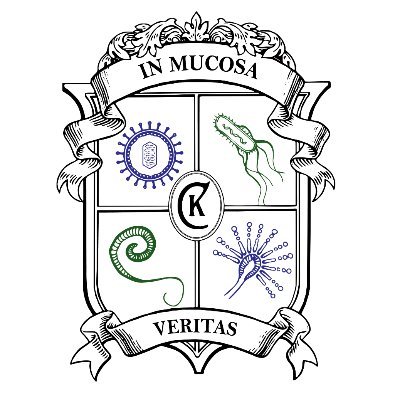
Cadwell Lab
@CadwellLab
Followers
2K
Following
1K
Media
57
Statuses
413
We investigate the interface between the immune system and diverse infectious agents ranging from friendly gut microbes and viruses to disease-causing parasites
Philadelphia, PA
Joined September 2019
Overall, we discovered that an intervention as simple as changing cages can control duration of viral infection in mice. Huge shoutout 🙏 to Christin and coauthors, the Gnotobiotics core at both Penn and NYU, and PennCHOP microbiome program for making this study possible 5/5
0
0
1
Cage change is a stress-inducing event for 🐭! We found that the fluctuation of glucocorticoids (hormones released under stress) contributes to viral clearance, and interference with this hormonal stress response actually inhibits MuAstV clearance after cage change! 4/5
1
0
0
Although continuous exposure to the virus does contribute to this persistent infection, we found that there is more at play here. In fact, cage change induces the activation of CD8 T cells and an interferon response in intestinal epithelial cells, driving clearance of MuAstV 3/5
1
0
0
We found in this study that Murine Astrovirus (MuAstV), an enteric RNA virus that is prevalent in wild, lab, and pet store mice, persists indefinitely in mice when they remain unperturbed in their cage. However, MuAstV is rapidly cleared after we change a mouse’s cage 🤯 2/5
1
0
0
Congratulations Christin Herrmann and team for publishing this super cool discovery 😎 https://t.co/FbXtzG2t4n Here’s a quick summary of our cool findings about how stress due to simple mouse husbandry drives clearance of persistent enteric viral infection 🦠🐭 1/5
nature.com
Nature Microbiology - Cage change of mice with persistent murine astrovirus infection triggers stress responses marked by corticosterone fluctuation, which is followed by CD8 T cell activation and...
2
3
20
Once again, 🙏NIH for making this possible and our amazing coauthors. Special shoutout to coauthors Patty Martin and @TorresVJ_Lab for launching this project. Read paper for details and credit to literature for background 5/n
1
1
2
Maybe ATG16L1 T300A is under balancing selection, like hemoglobin and APOL1 variants that are protective if you have 1 copy but 2 copies are bad (sickle cell/kidney disease)🤷♀️? Lots of❓ surrounding mechanism that we’re continuing to work on 4/n
1
1
1
Turns out that mice heterozygous for the variant, but not homozygotes, are highly protected from Salmonella and Listeria due to enhanced inflammasome🔥activity! Macrophages from T300A heterozygous humans displayed similar enhanced inflammasome🔥3/n
1
1
2
Most people have at least 1 copy of the ATG16L1 T300A variant even though it’s associated with increased susceptibility to Crohn’s disease. What gives? 2/n
1
1
2
Congratulations @Ipiricyao and Eugene Rudensky for publishing this story! Big 🙏to NIH for making this work possible. Here’s a brief summary of this fascinating finding about a gene variant that YOU🫵most likely have 1/n https://t.co/objLYQzJyZ
3
6
20
Congratulations @YingHanChen7121 and Kim Zaldana for showing how B cells are altered when lab mice are released outdoors! https://t.co/yrts4bOXlm 1/n
science.org
Releasing laboratory mice into the natural environment enhanced maturation and activation of the humoral immune system.
2
16
62
We are eternally grateful that the NIH officers and reviewers have expressed enthusiasm for these types of studies. Return in investment for the growing dirty 🐁field is huge 🤯and will help industry, and gov’t funding is essential to support the next phase! 9/n
0
0
0
Recently, we received a great score 👍on a previous NIH grant and hope we can get it funded after incorporating helpful suggestions from reviewers 8/n
1
0
0
These multi-lab efforts representing a new discipline are built on years of NIH and non-NIH💰 rigorously vetted by leaders in the field, with investigators picking up where others left off 7/n
1
0
0
Also, this most recent study is part of a growing field looking at how “dirty mice” 🐁 (as opposed to squeaky clean lab 🐁) develop a more human👩-like immune system when exposed to microbes🦠 including this other recent one from our lab 5/n
1
0
0
@HHMI (through faculty scholar award) contributed flexible seed funding for initial studies and 3 universities chipped in infrastructure 3/n
1
0
0
This is a fantastic example of how gov’t 💰 is maximized by private and university funding. Investigators 👩🔬 supplies 🧪 and equipment 🔬 are NSF and NIH through both direct + indirect funds. @Ying- and Kim salaries are supported by Charles Revson and HHMI fellowships 3/n
1
0
2
Follow us on🦋 for the scientific context and the shoutout to collaborators @SBKoralov, Andrea Graham, and others. Here, we thought it would be important to explain how gov’t 💰makes these types of discoveries possible 2/n
1
0
2
Congratulations @YingHanChen7121 and Kim Zaldana for showing how B cells are altered when lab mice are released outdoors! https://t.co/yrts4bOXlm 1/n
science.org
Releasing laboratory mice into the natural environment enhanced maturation and activation of the humoral immune system.
2
16
62



